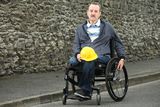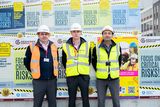‘It takes you three seconds to fall 26 feet’: Former construction boss warns others that risks still exist in building
Five building site workers have died on the job to October this year


Former construction boss James Gorry was on a routine job in Dublin when he slipped and fell off a 26-foot roof.
Confined to a wheelchair for almost 20 years, he says builders need to be more conscious of dangers on the job.
“I was doing some repairs to a roof. I had been working there for 18 years, I had huge knowledge and huge experience. And I got up on the roof to check the next day’s work, and I didn’t clip on the safety harness.
“I never classed it as a risk because I had done it so many times; the wrong way, obviously. One thing about when the body falls from a height, it won’t bounce. It’ll break, it’ll disintegrate or you’re dead. I’m paraplegic now.
“It takes you three seconds to fall 26 feet. I nearly died. But what happens is you die from the able-bodied world and you’re reborn in a disabled-bodied world. That’s just the way I look at it. Obviously, I can never function again in the able-bodied world. And I am the author of my own misfortune. It was my own fault.”
Mr Gorry has spent the last 18 years touring Ireland, the UK and Europe, educating people on workplace safety and telling them his own personal horror story. In October, for Construction Safety Month, he has been doing virtual appearances from a hospital bed he has set up at home and where he has spent the last seven months due to health issues.
His experience is not unique. Almost 7,000 construction workers have suffered non-fatal injuries in Ireland over the last 10 years, a figure that the Health and Safety Authority (HSA) – which monitors workplace safety legislation and can prosecute breaches – believes could be an understatement given many smaller contractors are unlikely to report.
While agricultural workers are by far the most likely victims of fatal accidents, construction has the highest rate of non-fatal injuries leading to four or more days’ absence from work, according to the HSA.
“The principal reason for fatal and serious accidents in the construction sector is falls from heights, and it continues to be so,” said Dermot Carey, director of safety and training with the Construction Industry Federation (CIF). “And the second is to do with mobile plant excavators and dumpers. They either result in a fatal accident or a life-changing accident. They continue to damage the industry and they continue to appear in statistics year on year.”
From this year’s construction industry federation safety month events, Gary Byrne – Operations Director, Paul Nicholls – Managing Director, Derek Murphy – Head of EHS
Fatal injuries at work dropped to an all-time low of 26 last year, the HSA says. Seven of those were in construction, a decline of around a third on the year before. As of the beginning of October this year, five construction workers have died on the job, according to the CIF.
“Of those, three related to falls from heights and two of those involved work that was being done on roofs in agricultural locations,” the CIF’s Dermot Carey said. “In one of those, the individual walked on a fragile roof and fell through. In the other one, the individual was installing solar panels and fell off the roof.”
Derek Murphy, head of environmental, health and safety at Irish building firm Designer Group, said poor mental health is often behind accidents at work. He has been spearheading more of a focus on well-being as chair of the Lighthouse Club construction industry charity, a UK and Irish organisation that offers counselling and financial help to struggling builders.
“A lot of the workers, they’re travelling around the country from job to job. They’re away from their families. Drink and drugs is an issue, as well, in the industry. Also, when you go in to a job, the minute you go into that job, you’re working yourself out of a job because it has to be finished at some stage. That plays on people’s minds, where is the next job coming from, where is the next paycheque coming from?
“I’ve met a lot of colleagues that have dealt with fatalities and serious injuries, and the effect that has on them personally, even though they might not know the individual that passed away, they take it personally. It has a huge effect on them.”
He says the pressure to build houses, data centres and climate infrastructure is putting more pressure on workers and could pose a safety risk.
“We need to start challenging the clients more that these timelines they’re putting against people, it’s not realistic. For example, data centres were probably taking two years to build. Now they’re building them in eight or nine months. The timeline is getting tighter all the time and ultimately, that affects the people that are delivering the projects. And that’s the workers.”
Mr Gorry says the industry has undergone a revolution since he had his accident, with safety training and personal protective equipment now par for the course. But the biggest wild card is the individual, he warns.
“People are out there in the workplace and they make the wrong call. They think it’s ok because they’ve done it last week or the week before. I’ll tell you the truth, if I didn’t have my accident, would I still do it the same way? I probably would. But it’s easy to say that now, isn’t it.”














.jpg)

